
The National Housing Supply Council (NHSC) on Friday released its latest annual report on housing supply and affordability (sorry I just got it). The following are extracts from the executive summary:
Housing stock and tenure:
Since 2001, detached houses have declined as a proportion of all dwellings, while medium and higher density dwellings have increased. While this has been, to date, a relatively small shift for the total housing stock, building activity data show that there has been a notable change in the balance of type of new properties being built, consistent with the focus of most capital cities’ strategic plans on infill rather than greenfield development and with the impact of increased congestion and travel times on the relative attractiveness of smaller, more expensive dwellings in high-amenity locations. Detached housing still accounts for the majority of new supply but to a lesser degree than has been the case historically. The higher rate of growth of apartments vis-a-vis detached houses is confined to capital cities and most pronounced in Victoria and the Australian Capital Territory (ACT). Across Australia as a whole, detached houses will dominate housing supply for the foreseeable future.
From 2001 to 2011, the total housing stock increased by a total of 17 per cent (equivalent to a compound growth rate of 1.6 per cent per annum), the occupied stock increased by 15.1 per cent (1.4 per cent per annum) and number of detached houses grew by 16 per cent (just over 1.5 per cent per annum).
Tenure patterns have changed significantly, with fewer younger and middle-aged people owning their own home and, across all age groups, fewer owning outright. The rate of home ownership in Australia is being sustained at about 70 per cent of households in private dwellings by the high rate of ownership of the present generation of older people. As time progresses, it now seems certain that the aggregate rate of home ownership will drop and the proportion renting will increase significantly.
Housing occupancy:
It is evident that the demographically-driven decline in household size has virtually stopped and that affordability pressures, among other things, are pushing in the opposite direction. There is clear evidence, for instance, of a marked increase in the propensity for Australian-born young adults to live in the parental home.
In 2011, 76 per cent of occupied private dwellings comprised three or four bedrooms. Unsurprisingly, most of these were separate houses, of which 89 per cent had three or four bedrooms. Meanwhile, 82 per cent of flats, units and apartments have one or two bedrooms, while 84 per cent of semi-detached dwellings have two or three bedrooms.
The most significant change in detached housing since 2001 has been the increased proportion with four or more bedrooms: from 32 per cent in 2001 to 36 per cent in 2006 and 39 per cent in 2011. There is anecdotal evidence of a trend in suburban redevelopment that sees larger homes replacing existing smaller houses. Growth in the stock of larger homes may also reflect changes in the purchase price of land — high land prices in and around the larger capital cities lead to changes in who can afford to build in these situations and in the nature of the dwellings they want — and the extension of existing homes to enhance potential capital gains.
Council members are often told that the supply of spare bedrooms in Australian dwellings could accommodate a substantial increase in population and that the policy challenge is to encourage people to move on from larger homes and to ‘right-size’ the homes they live in. While having spare bedrooms indicates a capacity to accommodate more people in reasonable comfort, it does not necessarily mean that dwellings are not being fully utilised. Households may put these ‘spare’ rooms to various uses (for example, study, office, gymnasium, craft or hobby room, children’s playroom, guest bedroom or storeroom).
Homelessness:
While the majority of the population is able to access adequate housing, between 2001 and 2011 there was an increase in both the number of people recorded as homeless and the number living in other marginal housing. While a myriad of social issues underlie homelessness and the use of marginal housing, the lack of available suitable low-cost housing contributes to people living in these circumstances.
Affordability still poor:
There have been a number of areas of notable change in the housing circumstances of the Australian population over the last decade. At the most extreme end of the spectrum, there has been an increase in the number of people living in ‘severely’ overcrowded conditions and other marginal housing. Tenure patterns have changed, with declines in rates of owner occupancy across the population. Couples, both with and without children, have experienced the largest falls in home ownership. There has also been an increase in the share of those approaching retirement age that still have a mortgage. Many of these changes are likely to have been at least partly driven by the increase in house prices over the decade, making it harder for people to get onto the housing ladder and taking out proportionately larger mortgages when they do.
Housing supply responses to changes in affordability:
The research indicates that the predominant response to declining affordability is more evolutionary — reduced dwelling and lot sizes, especially in the new home-buyer market segment, with some related changes to design and the use of cheaper or more efficient materials that reduce time (and therefore costs) on site…
In the face of rising land prices and more widespread development contributions, it could be argued that this downsizing of products has been essential to meet many consumers’ ability to pay and thus maintain sales. But it could also challenge consumers’ expectations and bear on modes of development and construction. It is certainly evident that predominant approaches to greenfield development over recent decades are under stress. The recently observed move away from ‘traditional’ new homes to smaller attached homes and apartments might fail to satisfy some potential buyers and begs the question of whether the demand for these new products is sufficient to sustain the present mix of large-scale master-planned communities and small land developments. Relatively stronger demand for smaller new dwellings created through ‘densification’ of inner-city areas and existing suburbs in capital cities also potentially challenges the size and structure of greenfield development.
The NHSC report also includes some interesting charts illustrating the tightening of housing supply and changing housing dynamics, including:
Rental growth outpacing income growth:
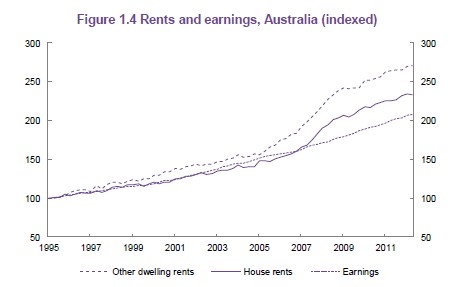
Building approvals showing zero supply response to rising prices and population growth:
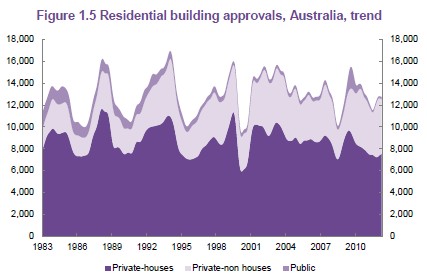
Declining housing affordability:
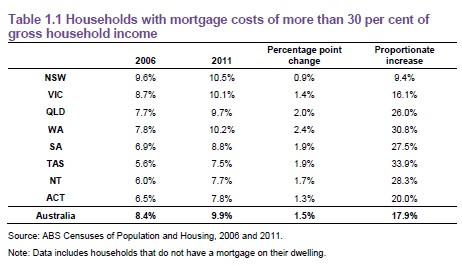
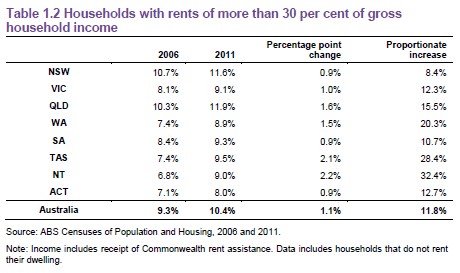
The shift away from houses to apartments:
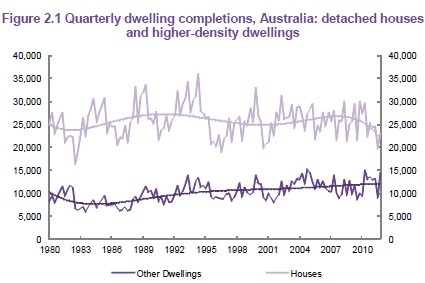
The full 162-page report is below.
NHSC – Housing Supply & Affordability Issues (March 2013)

